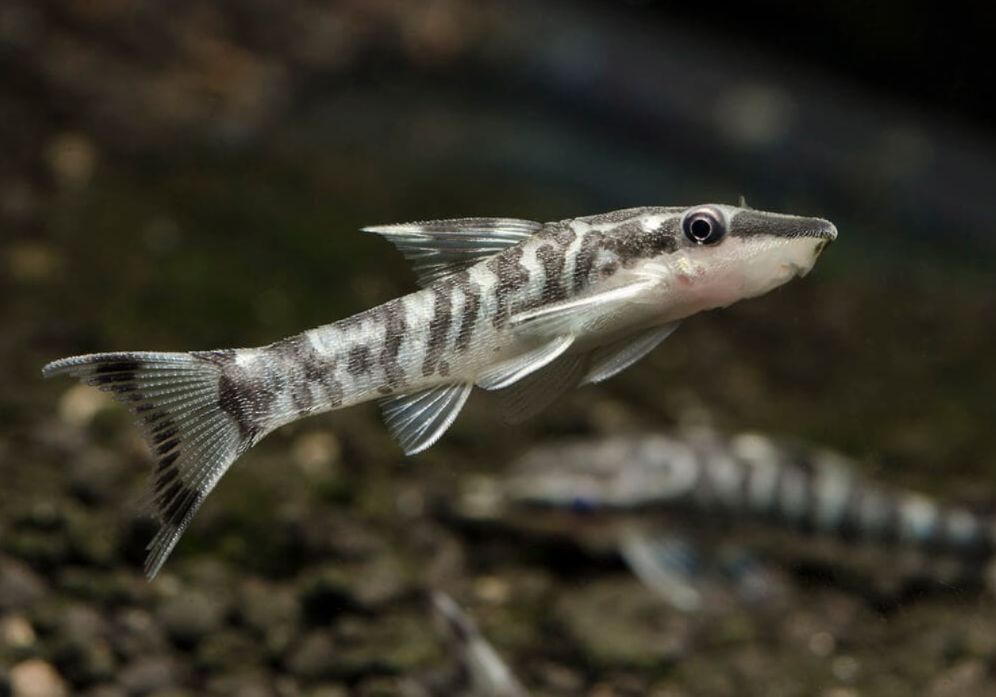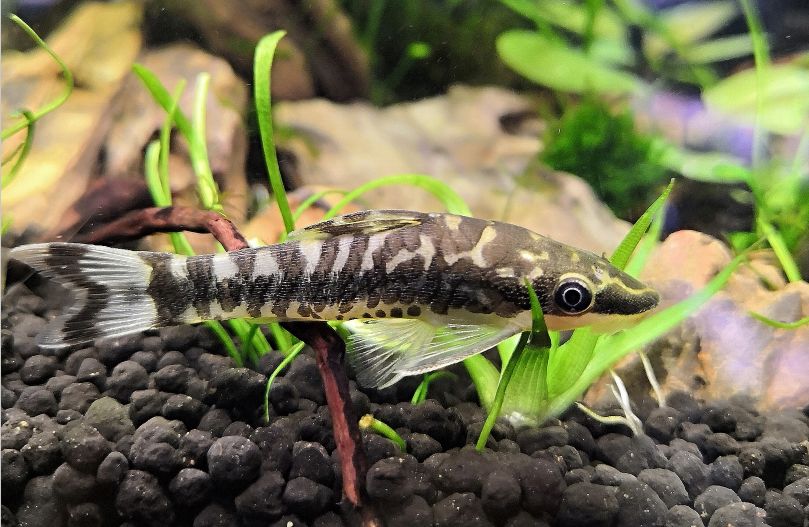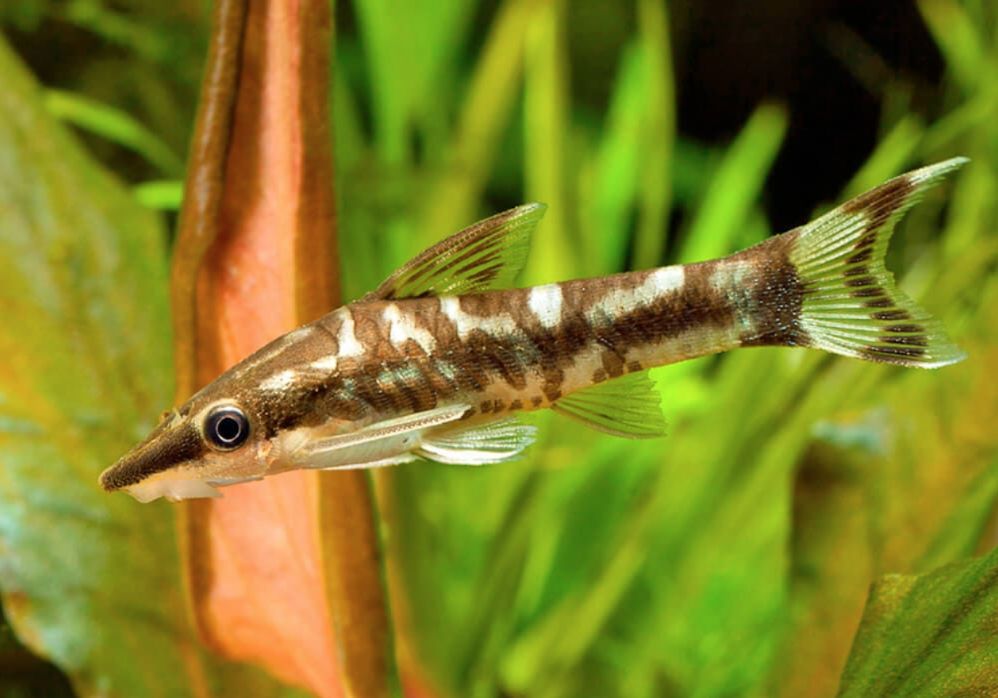Zebra otocinclus (Otocinclus cocama) is one of the smallest catfishes from Loricariidae family. It will tirelessly help you fight with algae in a tank. However, it is more seldom encountered in aquariums than Otocinclus affinis.

Contents
Habitat in the wild
The zebra otocinclus, often known as Otocinclus cocama or Zebra Oto, is a small freshwater fish belonging to the family Loricariidae. This family is commonly referred to as the “suckermouth catfish” family, and it includes a wide range of species, many of which are popular in the aquarium hobby.
The Loricariidae family includes a diverse group of catfish species that are known for their characteristic sucker-like mouths, which they use to attach to surfaces in the aquarium, such as glass, plants, and decorations. These fish are primarily bottom-dwellers and are well-known for their ability to help control algae growth in the aquarium.
The zebra otocinclus (Otocinclus cocama) is native to the Amazon River basin in South America, specifically in the country of Peru. Its natural habitat consists of slow-moving streams, tributaries, and shallow waters in the Amazon rainforest.
In this region, you’ll find a combination of aquatic vegetation, submerged tree roots, rocks, and leaf litter. These habitats often have gentle water currents and are densely planted with aquatic plants, which provide cover and a source of food for the zebra otocinclus.
The water in its natural habitat tends to be relatively clear and well-oxygenated, and the temperature can vary but generally falls within the tropical range. Maintaining similar water conditions in the aquarium (clear, well-oxygenated, with appropriate temperature) is important for the health and well-being of Zebra otocinclus when kept in captivity.
| Scientific Name | Otocinclus cocama |
| Family | Loricariidae |
| Common Names | Zebra oto; zebra otocinclus; tiger otocinclus; otocinclus zebra |
| Ease of keeping | Hard |
| Lifespan | up to 5 years |
| Tank size | 13 gallons and more |
| Temperament | Peaceful |
| Tank type | Community of small fishes |
| Diet | algae eater |
| Temperature | 22 – 26 °C (71-79 °F ) |
| pH | 6.0-7.5 |
| Water hardness | 4–18 dGH |
| Size | 4.5 cm (1.8 inches) |
Description
Size
The Otocinclus cocama is a relatively small fish, typically reaching a size of about 1.5 to 2 inches (3.8 to 5 centimeters) in length when fully grown. This compact size makes them well-suited for smaller aquariums and community tanks, where their peaceful nature and algae-eating behavior are highly valued. Due to their size, they can navigate smaller spaces and coexist peacefully with other small, non-aggressive fish species.
Lifespan
The lifespan of zebra otocinclus in captivity can vary based on factors such as water quality, diet, tank conditions, and overall care. Generally, when well-cared for in a suitable aquarium environment, zebra otocinclus can live for around 3 to 5 years. However, it’s important to note that individual lifespans can differ, and some may live longer or shorter than this average range.
Body
Zrbra oto body shape is the same as that of other Otocinclus species. This is a small fish with a suckermouth and an armored body.
The zebra otocinclus coloring makes it different from other species of its kind. Head and back have bluish white or a bit yellowish coloring. The top of the head and the area between the fish nostrils is black, bottom side of the fish head is light yellow; sides of the fish head and areas behind its eyes are black with V-shaped white stripe on the fish face.
On the fish back and sides there are 4 black or dark gray elongated spots: the 1st one is located at the beginning of the dorsal fin, the 2nd one is behind the dorsal, the 3rd one is between the dorsal and fluke fins, the 4th is at the beginning of the fluke. The zebra oto has a black spot on its tail stalk and W-shaped vertical stripe on its fluke fin, which makes is differ from other species.
| Characteristic | Description |
|---|---|
| Scientific Name | Otocinclus cocama |
| Common Names | Zebra Otocinclus, zebra oto, tiger otocinclus |
| Family | Loricariidae |
| Origin | Amazon River basin, primarily in Peru |
| Habitat | Slow-moving streams, tributaries, and shallow waters with aquatic plants and submerged roots |
| Size | Typically grows to around 1.5-2 inches (3.8-5 cm) |
| Lifespan | 3-5 years (with proper care) |
| Temperament | Peaceful and non-aggressive, suitable for community aquariums |
| Diet | Primarily herbivorous, feeding on algae and plant matter |
| Water Parameters | Temperature: 75-82°F (24-28°C), pH: 6.5-7.5, soft to moderately hard water |
| Tank Size | A 10-gallon (38-liter) tank is suitable for a small group |
| Behavior | Bottom-dwelling, frequently attaches to surfaces using their sucker-like mouths |
| Care Level | Moderate – requires a well-maintained aquarium with good water quality and proper diet |
| Algae Control | Effective at controlling algae, but supplemental feeding may be necessary |
| Compatibility | Generally compatible with peaceful fish species and other small, non-aggressive fish |

Difficulties in keeping
The zebra otocinclus is rather demanding and troublesome to keep. Some of species sold in pet shops are still delivered from their habitats, which leads to high mortality rates of the fish during the adaptation period. When keeping the fish in a home tank, it requires perfectly clean water and nutritious diet.

Keeping in a tank
Tank size
A suitable tank size for zebra otocinclus (Otocinclus cocama) depends on the number of fish you plan to keep and the overall setup of your aquarium. Zebra otocinclus are small fish, typically reaching about 1.5 to 2 inches (3.8 to 5 cm) in length, so they don’t require a massive tank. However, it’s important to provide enough space and proper conditions to ensure their well-being.
A 10-gallon (38-liter) tank is often considered the minimum tank size for a small group of zebra otocinclus. This size provides enough space for a few individuals and allows for a stable environment with adequate water quality. When considering the tank size, consider factors such as:
- Number of Fish: Zebra otocinclus are social fish, and they should be kept in groups to help reduce stress and exhibit natural behaviors. A group of 4 to 6 individuals is a good starting point.
- Aquarium Setup: If you have a densely planted aquarium with ample hiding spots, driftwood, and other decor, the fish will feel more secure and comfortable, even in a smaller tank.
- Compatibility: Ensure that the tank mates are also suitable for a smaller tank and won’t create overcrowding issues.
- Filtration and Water Changes: Smaller tanks can be more sensitive to water quality changes, so regular maintenance, proper filtration, and water changes are essential.
While a 10-gallon tank can work for a small group of zebra otocinclus, if you have the space and resources, providing a slightly larger tank, such as a 20-gallon long or even larger, can offer more swimming space and allow for a more stable environment. Ultimately, the goal is to provide a well-maintained tank that meets the needs of the fish you keep.
Water parameters
The most suitable tank water parameters are the following:
- Temperature: Zebra otocinclus prefer a tropical temperature range similar to their natural habitat. The ideal range is between 75°F to 82°F (24°C to 28°C).
- pH: The pH level should be kept within the slightly acidic to neutral range. Aim for a pH between 6.5 and 7.5.
- Water Hardness: Zebra otocinclus thrive in relatively soft to moderately hard water. Aim for a general hardness (GH) of 2 to 12 dGH.
- Ammonia and Nitrites: The fish requires crystal clean water with low level of nitrates and ammonia content. Keep ammonia and nitrite levels at zero. These compounds are toxic to fish, and regular water testing is crucial, especially during the initial setup of the aquarium. Weekly water renew and using special tests to define tank water parameters is a must in this case.
- Nitrates: While zebra otocinclus can tolerate low to moderate levels of nitrates, it’s best to keep them as low as possible. Ideally, maintain nitrates below 20 ppm (parts per million).
- Filtration: A good quality filtration system is important to maintain water quality, as zebra otocinclus are sensitive to poor water conditions. Ideally you should use external filter, but taking into account the fact that usually the fish is kept in small sized tanks, internal water filter will do as well.
- Aquarium Decor: Provide plenty of hiding spots among live plants, driftwood, and other decor. A well-planted tank with smooth substrates is beneficial. Zebra otocinclus requires thickly planted tank with a stable biological balance in it. It is desirable to add some fluctuants and snags into the tank as well as to put some fallen leaves on its bottom.
- Water Movement: Zebra otocinclus come from slow-moving streams, so aim for gentle water circulation to replicate their natural environment.
- Tank Mates: Choose peaceful and non-aggressive tank mates that won’t compete with them for food. Avoid large or aggressive species that might stress or harass the otocinclus.
Regular water changes (about 20-25% every 1-2 weeks) are essential to maintain stable water conditions and remove accumulated toxins. Monitoring the water parameters using appropriate testing kits is crucial for the ongoing health of the fish.
Diet
What do zebra otos eat? Fish has a vegetarian diet. In the wild it feeds with algae and biological fouling. During the adaptation period the fish should have enough of green and brown soft algae in a tank. The algae should form a biofilm on the tank plants and decorations.
Zebra otocinclus will scrape and eat this biofilm. Without it the fish will starve.
With time the fish will get used to eat some other food. This can be spirulina or pellets for phytovorous catfish species. Except artificial food you can feed with natural food – vegetables, for example. Cucumbers, marrow squash and parboiled spinach is the best option in this case.
Otocinclus cocama can eat other kind of food as well, but its diet must contain large amount of various vegetable food.
Tank mates
Zebra otocinclus is a rather peaceful fish and it can be kept in a community tank, but its small size and timid temper make it rather vulnerable. Therefore, it is better to keep the fish separately in a species tank or together with other small peaceful fishes such as guppy or neon tetra. Small sized shrimps will also do as a tank mates, red cherry, for example.
Zebra otocinclus is a schooling fish, which should be kept in a tank in a school of at least 6 species. The tank should be thickly planted, since the fish is active during the day and it eats algae fouling from tank plant leaves. Besides, tank plants are also a shelter for the fish.
Without tank plants and shelters oto won’t feel safe in a tank and this stress can easily lead to various health issues and early death of the fish.
There are some comments saying that oto nips other fishes bodies from sides, but I’d say that it must have happened due to stress or lack of vegetable components in the fish diet.
Gender differences: male vs female
Distinguishing between male and female Otocinclus cocama can be quite challenging, especially when they are not in breeding condition. In many cases, there aren’t any easily noticeable external differences between the sexes. Unlike some other fish species where males might have more vibrant colors or distinct physical features, the visual differences between male and female zebra otocinclus are subtle or not well-defined.
In some species of Otocinclus, during the breeding season, females might appear slightly rounder and plumper due to the development of eggs. However, these differences are not always easy to see, and the fish need to be in breeding condition for such distinctions to be noticeable.
In the absence of prominent physical differences, it’s often best to observe the behavior of the group. If you notice courtship behaviors (such as chasing or clustering), it might indicate that the fish are preparing for breeding, but this behavior can be challenging to observe in a home aquarium.
If your goal is to breed zebra otocinclus, you’ll likely need to provide specific breeding conditions in a separate tank and observe their behavior closely. If you’re simply interested in keeping them as part of a community aquarium, focusing on providing a suitable environment with proper care and maintaining a group of Otocinclus rather than trying to distinguish individual males and females is the recommended approach.
Breeding
Breeding zebra otocinclus in a home aquarium can be challenging, and it’s important to provide specific conditions and attention to encourage successful breeding. Here are some steps and considerations for attempting to breed zebra otocinclus:
- Select a Healthy Group: Start with a group of healthy zebra otocinclus, ideally with a balanced mix of males and females. A group of six or more is recommended to increase the chances of pairing and successful breeding.
- Create the Right Environment:
- Tank Size: Use a separate breeding tank with a size of at least 10 gallons (38 liters).
- Water Parameters: Maintain stable and suitable water conditions. Water temperature should be around 78-82°F (25-28°C), pH between 6.5 and 7.5, and relatively soft to moderately hard water.
- Lighting: Provide subdued lighting to mimic their natural habitat, as zebra otocinclus inhabit well-vegetated areas with diffuse lighting.
- Feeding: A varied and balanced diet is crucial. Offer high-quality foods, including algae-based foods, sinking pellets, and small live or frozen foods to ensure they receive proper nutrition.
- Conditioning:
- Feed your zebra otocinclus a high-quality diet leading up to the breeding attempt to ensure they are in optimal condition.
- Provide plenty of hiding spots in the form of live plants, fine-leaved plants, or spawning mops. These hiding spots will serve as potential breeding sites.
- Induce Spawning:
- You can try a large water change with slightly cooler water to simulate the rainy season, which might trigger spawning behavior.
- Alternatively, perform a slightly larger water change than usual with water at the same temperature, which could also trigger spawning.
- Observe Courtship Behavior:
- Look for signs of courtship behavior, such as males chasing females and inspecting potential spawning sites.
- When a female is ready to spawn, she will attach her eggs to surfaces, such as the undersides of leaves or other objects in the tank.
- Separate Eggs/Fry:
- Once you observe spawning, it’s a good idea to separate the eggs or fry to protect them from being eaten by adult fish or other tank mates.
- You can use a separate breeding box or transfer the eggs to a different tank.
Remember, breeding zebra otocinclus can be challenging, and success may not be guaranteed. Patience, attention to water quality, and providing suitable conditions are key factors in increasing the chances of successful breeding. If you’re successful, providing a separate rearing tank for the fry is important to give them the best chance of survival.